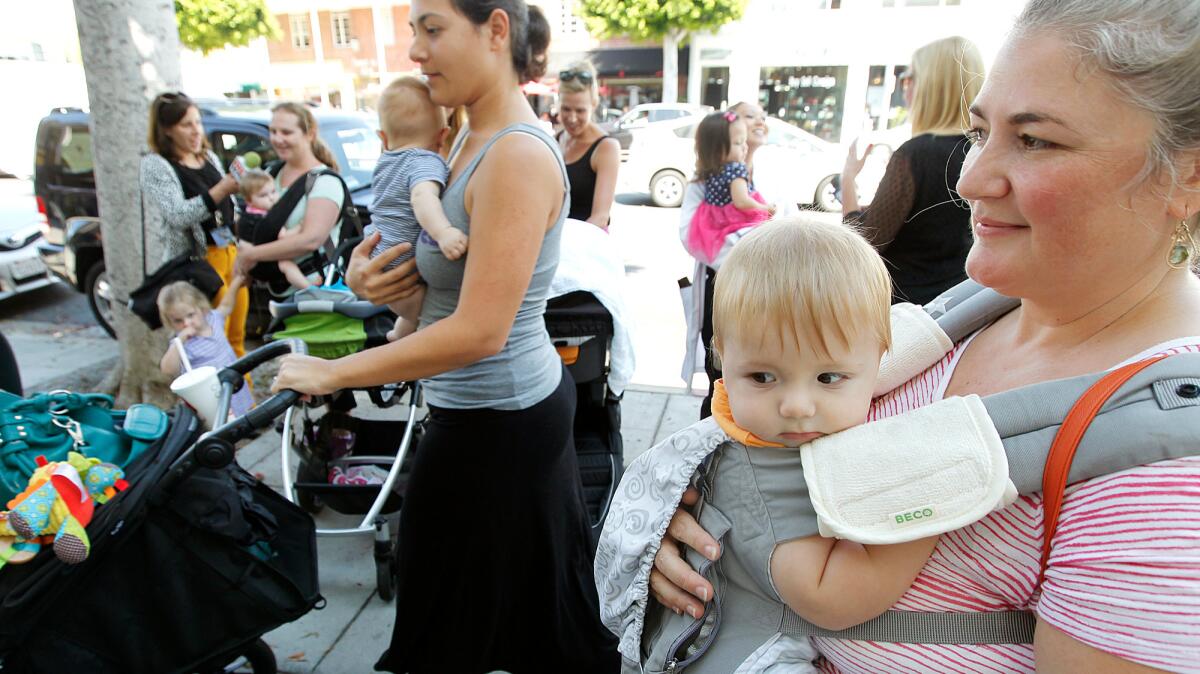Op-Ed: Breast milk is best and free, so why is it a luxury for American moms?

- Share via
In an immaculate mid-century spread nestled in the canyons of Beverly Hills, a Hollywood actress plucks her sleepy infant daughter from the co-sleeper bassinet attached to her bed and settles in for a cozy breastfeeding session. Soon, the child’s live-in nurse swoops in to bathe the baby.
Across town on L.A.’s East Side, a Guatemalan immigrant clutching her 2-month-old son in a blanket makes her way through the parking lot at a generic brick building. Inside, she waits to receive her monthly voucher from the federal Special Supplemental Nutrition Program for Women, Infants and Children, commonly known as WIC. Later, she will redeem it for infant formula and groceries.
I encountered both of these mothers in my research on breastfeeding in the United States. I know both women want the best for their babies: healthy childhoods and, later, adult lives filled with promise. Yet these two mothers — and those who fall between the extremes they represent — live in a nation where the fundamental ability to nourish their young with free, life-sustaining mother’s milk has been turned into a luxury for the elite, or a hard-fought prize for the intrepid.
“Breast is best” may be a national mantra but here is the reality: Although nearly 80% of U.S. mothers start off breastfeeding their babies, half will give it up entirely or supplement with formula after just a few weeks. Less than 19% of American babies receive the six months of exclusive breastfeeding recommended for optimal growth, development and health by the American Academy of Pediatrics, the World Health Organization and countless scientists, doctors and public health experts.
We now know that breast milk is not merely a foodstuff, but a mysterious and powerful human tissue — a constellation of complex nutrients, bioactive molecules, hormones, microorganisms and as yet barely understood compounds that have evolved over eons to ensure the survival of the human species. We also know that feeding babies infant formula instead of breast milk is associated with increased incidence of gastrointestinal and respiratory infection, as well as greater risk of obesity, type 1 and type 2 diabetes, leukemia and sudden infant death syndrome.
Unfortunately, there is a sharp socioeconomic divide when it comes to breastfeeding. Studies show a distinct correlation between parents’ income and education levels and a mother’s likelihood of breastfeeding. Privilege helps a lot.
The actress I met, for example, gave birth in a hospital that has adopted the essential practices required by the Baby-Friendly Hospital Initiative, a global program launched by the WHO and Unicef in 1991 to support breastfeeding. It doesn’t automatically hand out free formula to mothers. It provides rooming-in maternity suites for mom and baby, so moms can breastfeed on demand. And it maintains lactation staffers for support; breastfeeding may be a biological process, but there’s a learning curve involved.
Studies show a distinct correlation between parents’ income and education levels and a mother’s likelihood of breastfeeding. Privilege helps a lot.
This affluent mom also could afford a renowned pediatrician who made breastfeeding a cornerstone of his practice (most U.S. doctors receive little education on human lactation in medical school). And with a nanny to assist her and the means to stay at home, she had the luxury of time to nurse for at least another six months after her baby started eating solid food, another AAP recommendation.
Such advantages aren’t as available to the immigrant mother in East L.A. The city has worked to increase the number of Baby-Friendly hospitals, but half of moms still lack access. (Nationwide, only 17% of births occur in these facilities.) And like the majority of American working mothers, the WIC mothers I encountered will likely get no paid time off after giving birth: The United States is the only industrialized nation (and one of just a few countries in the world) that does not mandate paid maternity leave.
Certainly, lactation educators at WIC also discuss the importance of breastfeeding, and many WIC mothers initially opt for the program’s “partially” or “fully” breastfeeding packages. But few have time to make use of WIC’s free lactation support. The clinic I visited provides women with hospital-grade breast pumps to use at work, but many employers don’t meet their legal obligation to provide nursing mothers with breaks and a clean, private space (other than a bathroom) for pumping. Few women protest, for fear of losing their jobs.
It’s not surprising, then, that when WIC mothers have difficulty breastfeeding, they often resort to supplementing their efforts with the program’s free formula. Then their own milk supply dwindles, and the switch to WIC’s “fully formula feeding” package becomes inevitable. The federal WIC program, whose single largest expense is the formula it provides free to mothers, now serves an astonishing 53% of American infants.
Breastfeeding is only marginally easier for working mothers at higher income levels in America. Back on the job after her short maternity leave, my ad-exec sister-in-law had to pump in filthy airport bathrooms between flights. My other sister-in-law, a nurse practitioner, pumped in a germy exam room, between patients. A salaried “learned professional,” she was exempt from the federal Fair Labor Standards Act that requires bosses to provide breaks and pumping space. Then there’s my story: After my husband and I became parents, I opted to freelance from home, allowing me to breastfeed and save on childcare. It took five years to pay off the resulting debt.
Nations far less prosperous than the United States have successfully addressed breastfeeding inequity. Vietnam cracked down on formula advertising and upped maternity leave to six months, allowing all mothers to meet the WHO’s breastfeeding guidelines. Taiwan made more than 75% of its hospitals Baby-Friendly, and its once-abysmal breastfeeding rates skyrocketed. India, Brazil and South Africa now treat breastfeeding as the important public health issue it is, with programs and policies that give children a chance to thrive. It’s inconceivable that the United States would be content to give our children less.
Jennifer Grayson is the author of the recently published book “Unlatched: The Evolution of Breastfeeding and the Making of a Controversy.”
Follow the Opinion section on Twitter @latimesopinionand Facebook
MORE FROM OPINION
Will the GOP convention be a celebration of anger and exclusion
I have terminal cancer and I know my friends want to ask, ‘Aren’t you dead yet?’
More to Read
A cure for the common opinion
Get thought-provoking perspectives with our weekly newsletter.
You may occasionally receive promotional content from the Los Angeles Times.










